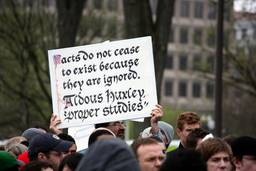Last week, the Chamber of Commerce jumped into the fray again over the Employee Free Choice Act by purportedly “debunking” research that showed widespread employer coercion and labor law violations.
As reported by a policy newsletter, Bureau of National Affairs:
The chamber said the report, “Union Studies on Employer Coercion Lack Credibility and Integrity,” looks into the union studies’ “self-serving research intended to support a pre-ordained result.” The report focuses on studies that are cited by organized labor and its allies as evidence of claimed illicit behavior by employers.
“Proponents of EFCA repeatedly cite the same studies to support their claims for overhauling our labor laws,” said Randel K. Johnson, Chamber senior vice president for labor, immigration, and employee benefits. “But this single study exposes the lack of credibility to their arguments. They say changes are needed because employer tactics create a coercive environment during organizing drives. But these studies show no pattern of employer coercion and certainly don’t justify overthrowing our current system of labor laws.”
Johnson said the report finds the pro-union studies used flawed methodologies, misused government data, misinterpreted federal labor laws, and distorted statistics.
Is this the same Chamber of Commerce that funded researchers who apparently cooked Canadian data to show that the Employee Free Choice Act would put out of work 600,000 American workers in its first year?
(A Chamber spokesperson declined to answer criticisms of its own research at press time.)
Yes it is, as I pointed out in this In These Times article exploring the work of its two primary subsidized academics, Anne Layne-Farrar and Richard Epstein: “Shilling on the Corporate Dollar.“ As the article pointed out:
Layne-Farrar’s and Epstein’s conclusions serve as the academic veneer for the PR blitz that has tried to demonize the Employee Free Choice Act.
Despite the wide dissemination of Layne-Farrar’s report, critics like Chris Kromm of the Institute of Southern Living have found distortions and shoddy analysis in her work. Of the 10 Canadian provinces she studied, Kromm discovered that only three actually had significant changes in card check rules. And he found that the report itself acknowledged there wasn’t enough data to draw conclusions about the impact of card check. It further admitted that the provincial card check data they did collect was too “weak” for economic analysis. Kromm also wondered, “If unions really were the cause of unemployment, why has Canadian unemployment risen in recent years…even as union membership has declined?”
But Layne-Farrar massages the data using a complex “regression analysis” to connect the dots between card check, higher unionization rates and more unemployment, putting the loss at between 600,000 and 2.6 million new American jobs in the first year.
“That’s bullshit,” says Canadian labor economist Charlotte Yates, now the Dean of Social Sciences at McMaster University in Hamilton, Ontario. “I don’t know of any credible economists who say [now] there is a direct correlation between unionization and the rise in unemployment.”
So how credible are the Chamber’s attacks on reports documenting employer abuses?
Let’s look at the attack the Chamber launched at one Economic Policy Institute-released study by noted labor scholar, Kate Bronfenbrenner of Cornell University:
For example, the [Chamber] report said, the study “No Holds Barred,” released May 20 by the Economic Policy Institute (EPI) and American Rights at Work, alleged that employers fired union organizers and made illegal
threats in a large number of cases. However, the chamber report found that the primary source of information for that study was union organizers themselves…“Likewise, the allegations of widespread employer abuse, coercion, and intimidation in response to union organizing are based primarily on surveys and interviews of union organizers — hardly the credible and unbiased research one would expect from purportedly scholarly studies,” the report said.
Actually, as I reported in May, “She reviewed a random sample of 1,000 National Labor Relations Board elections and all those elections’ unfair labor practices documents and decisions, supplemented by in-depth interviews and surveys of organizers involved in over 500 campaigns.”
And as Ross Eisenbrey, vice-president of the Economic Policy Institute, says of the criticism that Bronfenbrenner speaks to workers and organizers: “Employer groups don’t believe the victims [of unionbusting], the workers. Who are you going to believe, the employers?” He adds, “Despite a very difficult burden of proof, unions are winning 45% of allegations.”
It’s little wonder that AFl-CIO spokesperson Eddie Vale, among others, was so dismissive of the Chamber’s report:
“Yawn…of course the Chamber disputes anyone that disagrees with them because they want to preserve the current system where they can illegally fire and harass workers trying to stand up for their rights,” Vale said in an e-mail. “Instead of churning out useless white papers defending the status quo maybe they should think about changing some of their policies so that major companies like Nike and Apple would stop leaving [Chamber membership].”
Naturally, the Chamber also ignored an EPI study showing that unionization doesn’t hurt employment. As I reported in March, “A new report for the Economic Policy Institute that definitively shows, showcasing decades of economic and labor board data, that the unionizing of firms has no impact on either job loss or closings.
“The myth that unionization will kill jobs and drive companies out of business is the biggest fear being stoked by the business lobby: it was still being peddled in a Republican-run “hearing” by the Senate Republican Conference that trotted out business owners and experts who proclaimed that the “terrifying” Employee Free Choice legislation would be a “disaster” for businesses.”
So why should we believe this latest report from the Chamber of Commerce?






